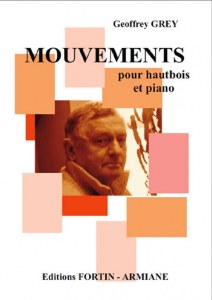"Movements" for piano and oboe by Geoffrey Grey
Reference EFA 71
Geoffrey Grey's movements for oboe (piano reduction)
Geoffrey Grey is a British violinist, conductor and composer, born in 1934 in Gipsy Hill. His precocious gifts allowed him to enter the Royal Academy of Music where he studied violin, composition, piano and conducting.
His composition teachers were William Alwyn and Benjamin Frankel, and later, in Paris, Nadia Boulanger. His path crossed that of Edwin Carr, a New Zealand composer who would become a faithful friend (see the works of E Carr published by Armiane, including a concerto for oboe).
As a freelance violinist, he composes for various combinations of instruments.
In 2003 Geoffrey Grey contacted the oboist Dominique Enon, this meeting will prove fruitful and he will return to France to perfect his skills under the direction of Kurt Masur at Radio France. Several of his works are published in France.
Mouvements :
"I dedicated this series of short "Mouvements" to my friend Dominique Enon in the summer of 2012. They are connected to each other.
These "Movements" could use a full orchestra. The piano part is a bit more demanding than the oboe part."
Geoffrey Grey on November 29. 2013
I composed this work for my friend Dominique Enon during the summer of 2012. I chose to call it "Mouvements" because it being, in fact, a series of inter-related short movements
The piece calls for a full orchestra and the piano part is therefore somewhat demanding.
Geoffrey Grey, November 29th, 2013
Article from the British Double Reed Society Movements for oboe and piano. Geoffrey Grey Edition: FORTIN-ARMIANE
When Bartok transformed the familiar intervallic relationships of diatonic musical language into an axis System, unique to himself, several masterpieces resulted. In Geoffrey Grey's Mouvements we fmd a similar transformation of diatonic harmony into a language full of chromatic diversions which are constantly surprising. The original version is for orchestra and solo oboe, with a great deal of intensive string writing as the main colour in the orchestral texture. There is a close relationship in the material relating to the soloist and the orchestra/piano with no suggestion of an accompaniment intruding into the dialogue. This is a very important feature in the piano version, which encapsulates the varying motivic material of the orchestral version in a vivid display.
In neither version is the oboe ever crowded by the piano or the orchestra. The transparency of the textures keeps the soloist in effortless relief throughout. This is especially important when hints of quotations are introduced at various points. There is even a suggestion of the Elgar Cello Concerto at the opening with three bars replicating the rhythmic structure of the opening cello motif. The most obvious one is in the episode preceding the coda: the oboe bas a wonderfully apposite melody, evoking Pachelbel. These elements are sometimes introduced at the opening of the varying sections of the work. This episodic structure is reflected in the title. It is rather like a mosaic of differing blocks which formulate contrasting elements, but establish a wonderfully cohesive structure. The skill with which this is achieved provides the oboist with a vast array of characteristics which portray the instrument in all its beauty and virtuosic display.
Each section begins with a diatonic statement which belies the material it leads to. This is especially so in the second section, which opens with a repeated triad. As the counterpoint develops into chromatic complexity the interplay with the orchestra/ piano becomes intense and exciting, only to be interrupted by an intentional cliche which deceptively opens the following section, containing brief references to a well-
known tune and the Pachelbel quotation. After a stark silence the coda unités the soloist and orchestra/piano in a rapid display of intensity.
The variety of mood and gesture in the work make it an ideal closing item for a recital. There are profound moments, display sections and moments of light-hearted fun. Such a variety of characteristics is not easy to encapsulate in a single composition, but Grey has succeeded in making this imaginative kaleidoscope into a work which is suitable for all occasions. One or two tough moments technically do not put it out of reach of an able Grade 8 candidate. But most of all it is an attractive and skilfully composed work which would




